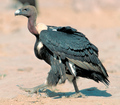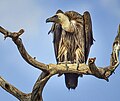Aegypiinae
| Aegypiinae | |
|---|---|

| |
| Lappet-faced vultures (left) and a white-backed vulture | |
| Scientific classification | |
| Domain: | Eukaryota |
| Kingdom: | Animalia |
| Phylum: | Chordata |
| Class: | Aves |
| Order: | Accipitriformes |
| Family: | Accipitridae |
| Subfamily: | Aegypiinae Sclater, WL, 1924[1] |
Aegypiinae is one of two subfamilies of
Old World vultures, the other being the Gypaetinae. They are not closely related to the Gypaetinae, and are instead a sister group to the serpent-eagles (Circaetinae).[2][3]
Presently found throughout much of Africa, Asia, and parts of Europe, fossil evidence indicates that as recently as the Late Pleistocene, they ranged into Australia.[4][5]
Taxonomy
The
molecular phylogenetic study of the Accipitridae by Therese Catanach and collaborators that was published in 2024.[3]
| Aegypiinae |
| ||||||||||||||||||||||||||||||
Genera
| Genus | Common and binomial names | Image | Range |
|---|---|---|---|
Necrosyrtes Gloger, 1841
|
Hooded vulture Necrosyrtes monachus |

|
Sub-Saharan Africa |
| Gyps Savigny, 1809 | Griffon vulture Gyps fulvus |

|
Mountains in southern Europe, north Africa and Asia |
| White-rumped vulture Gyps bengalensis |

|
Northern and central India, Pakistan, Nepal, Bangladesh and southeast Asia | |
| Rüppell's vulture Gyps rueppelli |

|
The Sahel region of central Africa
| |
| Indian vulture Gyps indicus |

|
Central and peninsular India | |
| Slender-billed vulture Gyps tenuirostris |

|
The Sub-Himalayan regions of India and into Southeast Asia
| |
| Himalayan vulture Gyps himalayensis |

|
The Himalayas and Tibetan Plateau | |
| White-backed vulture Gyps africanus |

|
Savannahs of west and east Africa | |
| Cape vulture Gyps coprotheres |

|
Southern Africa | |
Sarcogyps Lesson, 1842
|
Red-headed vulture Sarcogyps calvus |

|
The Indian Subcontinent, with small disjunct populations in Southeast Asia
|
Trigonoceps Lesson, 1842
|
White-headed vulture Trigonoceps occipitalis |

|
Sub-Saharan Africa. Extinct populations have occurred in Indonesia.[6] |
Torgos Kaup, 1828
|
Lappet-faced vulture Torgos tracheliotos |

|
Sub-Saharan Africa, the Sinai and Negev deserts and north-west Saudi Arabia |
| Aegypius Savigny, 1809 | Cinereous vulture Aegypius monachus |

|
Southwestern and central Europe, Turkey, the central Middle East, northern India, central and east Asia |
| †Aegypius jinniushanensis | Pleistocene of China | ||
| †Aegypius prepyrenaicus | Pleistocene of Spain |
Fossil genera
| Subfamily | Genus | Common and binomial names | Image | Range |
|---|---|---|---|---|
| Aegypiinae | †Cryptogyps | †Cryptogyps lacertosus | Pleistocene of Australia | |
| †Gansugyps | †Gansugyps linxiaensis | Miocene of China |
† = extinct
References
- ^ Bock, Walter J. (1994). History and Nomenclature of Avian Family-Group Names. Bulletin of the American Museum of Natural History. Vol. 222. New York: American Museum of Natural History. pp. 133, 257.
- .
- ^ .
- S2CID 250938004.
- ^ "Mindat.org". www.mindat.org. Retrieved 2022-07-22.
- ^ Hanneke J.M.; et al. "Continental-style avian extinctions on an oceanic island" (PDF). Repository.si.edu. Retrieved 17 October 2018.
Further reading
- ISBN 978-0-618-12762-7. Retrieved 2011-05-26.
- Grimmett, Richard; Inskipp, Carol; Inskipp, Tim (1999). Birds of India, Pakistan, Nepal, Bangladesh, Bhutan, Sri Lanka, and the Maldives. Illustrated by Clive Byers et al. Princeton University Press. OCLC 43578307.
- Lerner, Heather R. L.; Mindell, David P. (November 2005). "Phylogeny of eagles, Old World vultures, and other Accipitridae based on nuclear and mitochondrial DNA" (PDF). Molecular Phylogenetics and Evolution. 37 (2): 327–346. PMID 15925523. Retrieved 31 May 2011.
